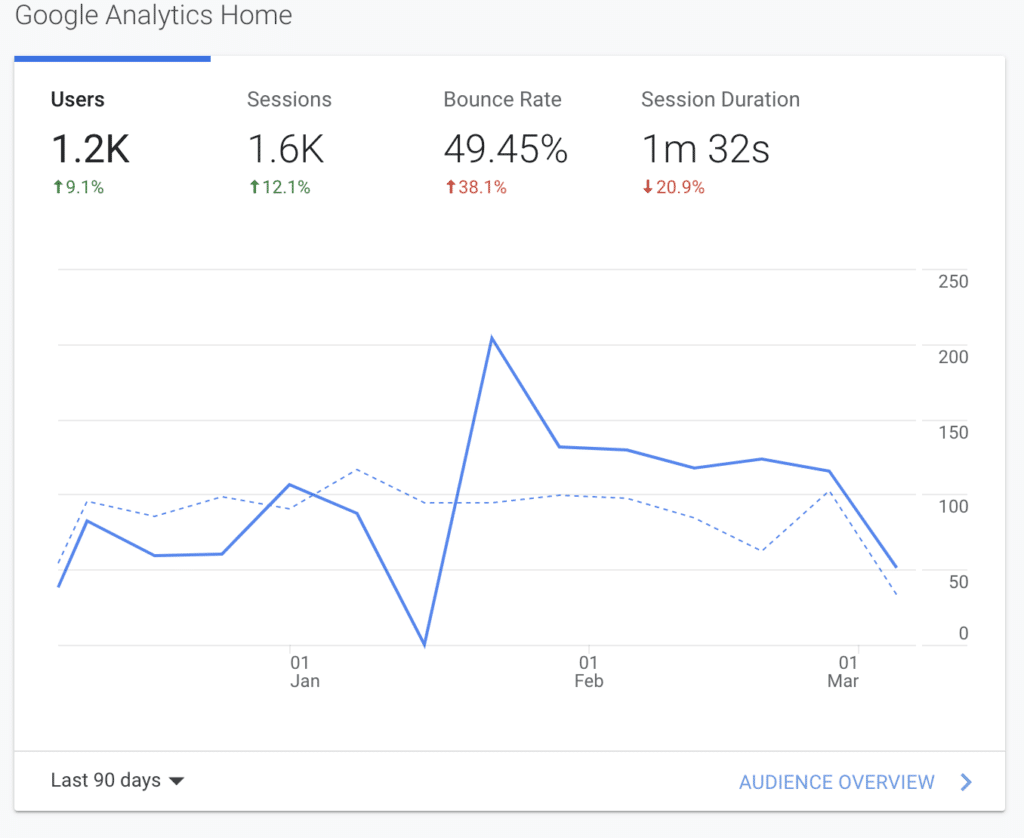
🔉 Calling all entrepreneurs who care about Data Analytics – this is the post that you NEED to read before July 1, 2023.
In case you haven’t heard, Google Analytics is moving to an entirely new way of tracking data on your website, called Google Analytics 4 or GA4. GA4 is an events-based measurement system while Universal Analytics (likely what your current website is on) is a sessions-based measurement system.
With this change, comes a different interface and new metrics that makes tracking your website’s performance much more accurate. Our team has been using and tracking our website’s analytics using the new GA4 since September of 2022 and have learned the ropes (and still are) so that it’s an easier transition for you. Let’s dive in.
This is the first and main question we want to address so that you are able to know the differences and what to expect. As mentioned above, it’s now a matter of difference between sessions-based tracking and events-based tracking, but what does this mean?
Universal Analytics is a sessions-based system.

Likely in your Universal Analytics dashboard, you’ll see analytics such as “sessions”, “bounce rate” and “session duration” – these are all session measurements. A session is defined as an interaction with your website whether that be in the form of page views, transactions or events. [1]. So, think of it as any time a person is interacting with your website!
Now that you are aware of what a sessions-based measurement looks like, what does an events-based measurement look like?
Google Analytics 4 uses an events-based system.

The attached screenshot above is the same report as shown in the Universal Analytics comparison, but showing completely different numbers. This is because of the new measurement based off of events. Events are defined as a specific type of interaction within your website. [2]. So, while Universal Analytics shows us each time someone hops on our website (a session), Google Analytics 4 is showing us not only the fact we have a new user on the website, but also what they are doing when they are on the website.
To explain this further, think of it this way: when a user hops onto your website, it starts a session. In the original Google Analytics, this would show as 1 active user on the website. In Google Analytics 4, it would show as 1 event and 1 active user. The event that was started based on hopping onto a website is called session_start.
As you can assume, 1 active user can have multiple events. Here’s just a few samples from our users on our website from the last 90 days of tracking with GA4:

You can find what each of these events actually mean on the Google Analytics 4 website.
There’s a few different things I recommend doing and knowing before migrating to Universal Analytics that I’ll explain in depth below:
Know your current analytics.
As obvious as this sounds, make a mental note to print, write down or export your Universal Analytics onto your computer for you to keep. This is good to have in order to compare data as your website begins tracking using the new GA4.
Understand that your actual “data” will not migrate over.
Although Google is working on this feature, there’s no way to “migrate” your physical data over to Google Analytics 4. This is due to a lot of the numbers being different with the new events-based tracking. So, that’s why we’d recommend exporting or having your actual reports somewhere to reference to ensure your numbers are similar to what they were previously.
Make note of all events, goals, UTM codes, or other advanced tracking metrics you had on your Universal Analytics account.
Because your data and reports don’t automatically transfer over to the new GA4, you’ll be responsible for recreating these metrics in the new account. This includes any “goals”, “conversions” or other advanced tracking metrics you had setup in Universal Analytics. For example,

In our Universal Analytics, we ran a test back in September on using the “goals” within Analytics. Essentially, you can create a “goal” based on your business and track it’s completion. For our business, we created a “goal” which was a client from our website completing and sending their inquiry form. We tracked this by tracking the amount of users and pageviews within our /thank-you page which can only be seen if our inquiry form was completed.
When we moved to GA4, we had to create a separate “event” for this as well as marking it as a conversion. For more information on how to do this for you business, reference this article.
Well, you have before July 1, 2023 to still have the ability to access Universal Analytics and transfer everything over. We would recommend doing this as soon as possible so that you can have a couple of weeks tracking both to ensure the data is coming over properly. When you are ready:
Login to your Universal Analytics account. At the very top, you should see the banner for the new GA4.
Once you click on this banner to begin the migration process, Google has a step-by-step guide to walk you through creating your new stream for GA4 and adding it to your website. *IMPORTANT: do NOT delete your tracking code from your website heading tag. Keep BOTH so that you can still get data in your Universal Analytics account. Deleting your Universal Analytics tag will stop all data from flowing in that account. Until you can confirm data is flowing, this is important!*
If you aren’t one for tutorials and want something done-for-you, we have a solution!
For a limited time, we are offering a Done-For-You GA4 setup. Sign up HERE to receive an email with form to complete – for $250 we’ll get access into your Analytics account and website. From there, we’ll connect everything without you having to lift a finger!
Once we finalize your connection, you’ll receive a 20-minute data interpretation video which walks through some key differences between the new measurement system and what to expect. Note: the interface is different – but don’t get overwhelmed. You’ll learn the ropes in no time! 🙂
Reach out to us at https://chloecreativestudio.com/contact with any questions or reach out to us on our Instagram – our DMs are always open friends!


© Copyright 2018 – 2024 Chloe Creative Studio. Privacy Policy. Terms. North Carolina. Photography by Sara Coffin Photo. Designed by Us :)